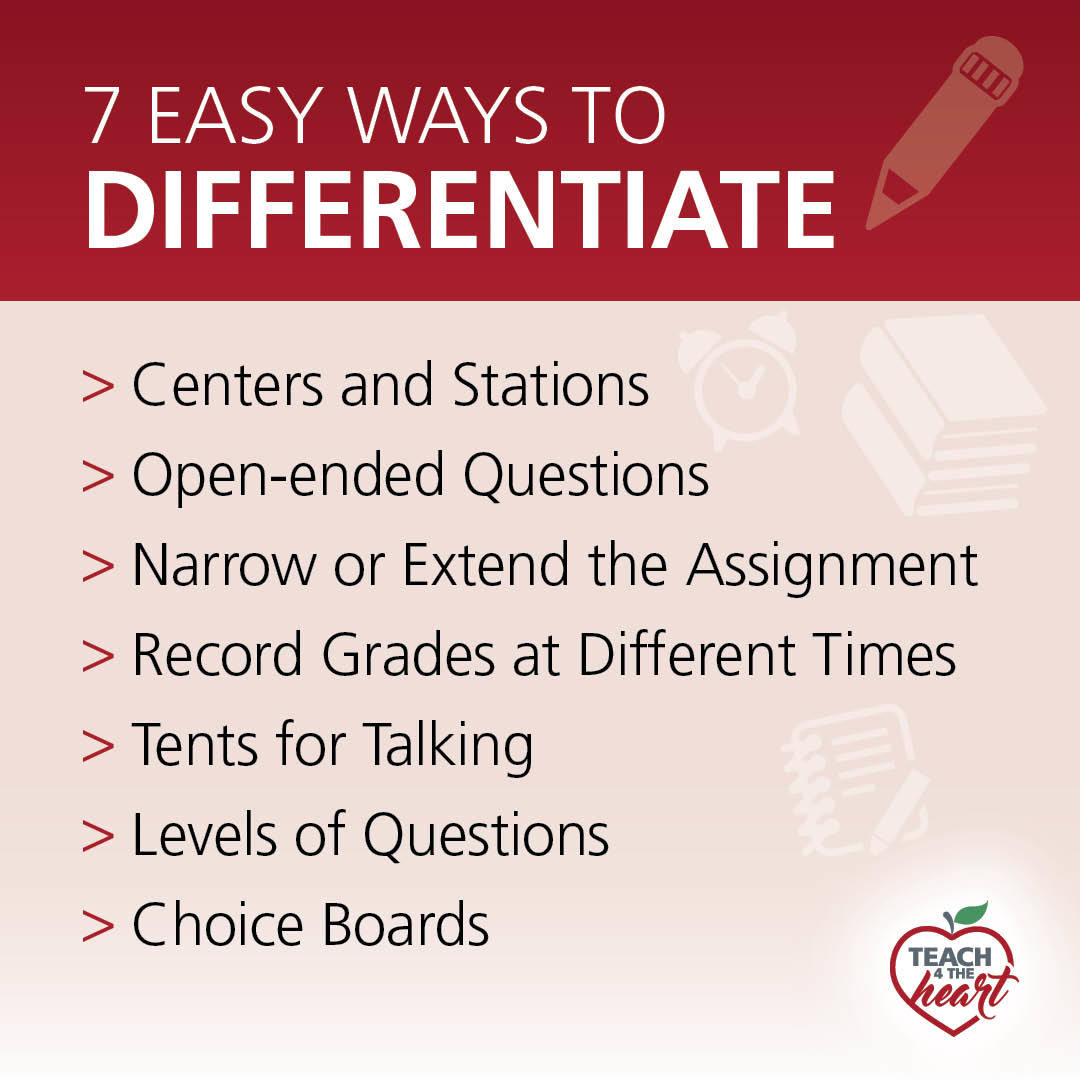
Trying to differentiate work can be stressful and time-consuming, but it doesn't have to be. Listen as Laura Kebart shares practical strategies to make differentiation simple and relatively easy.
Thank you to Poverty Encounter for sponsoring this podcast episode!
listen here:
what is differentiation (actually)?
There are a lot of misconceptions about what differentiation is or what it has to be. A lot of people think that differentiation means each student needs their own lesson plans, materials, and activities. But actually, differentiation doesn’t have to mean that every student is getting something completely different. You don’t have to scramble as a teacher to find a million different resources and create a bunch of different plans.
Differentiation is more about having strategies in your back pocket to teach the same material in different ways and providing students with different ways to access the material. Students all need exposure to the same grade level materials, but they can access them in different ways.
What does differentiation look like?
Differentiation can look like presenting a short story by reading it aloud with the students or having them listen to it via audiobook. Or I can have the students do choral reading and tell them to be ready to give me the next word when I randomly stop reading. This way, even if students don’t know the word, they have the opportunity to stay focused on the text. I can also have them read the passage in small groups.
If I have high-level questions to go with the story, such as, “Which details of the setting are most important to the plot?”, it’s another opportunity to differentiate. With students who are struggling, we may stop and talk about the fact that a setting is time and location. With students who are on grade-level, we explore, “What is this question asking? How can we re-word it?” I may look at the details and how they affect the plot with my students on a higher level. Everyone gets the same story and the same question, but we focus on different aspects of the question according to students’ levels.
In the beginning of the year, as a whole class, we will access the material in a variety of different ways together. I emphasize to my students that they can interact with the text in different ways. Then, as the year goes on, they can choose how they want to receive the content, such as an audiobook, reading together in a small group, etc.
Pin it for later ⤵
7 easy ways to differentiate
1. Centers and Stations
Centers and stations can help with differentiation. I bring small groups of students in to talk about the different aspects of that high-level question as one of my stations. Once students have been through this process of breaking down the question with a teacher a few times, it helps them figure out what is being asked and what part of it they can answer even if it’s not the whole thing. Instead of saying, “I didn’t do it because I didn’t get it,” students will say, “I understood the first part and answered that, but need help with the second part.” It gives them a lot more ownership.
2. Open-ended Questions
Including a lot of open-ended questions allows students to show you what they do know, even if they can't answer the entire question.
3. Narrow or Extend the Assignment
Everyone gets the same assignment, but to narrow it, you may say, “I just want you to do this part and then check in with me." You can highlight what you want them to do. After they check in with you, you can release them to do the next part. This ensures that students don’t go too far off in the wrong direction.
For the students at a high-level, you may ask a deeper question or ask them to make an additional comparison, possibly even with a second text.
4. Record Grades at Different Times
Another way to differentiate is to record grades at different times for different kids. If you’re talking with a student and you know they get it, record a grade for them right then. If you have a student who is struggling, take the opportunity to explain it to them and give extra time with the concept before you record the grade. You don’t necessarily need to wait and take home all the assignments at the same time and grade them all together.
5. Tents for Talking
Take a paper and fold it like a tent (cardstock works best). On both sides of the tent, you have question stems or sentence stems that are standards-based. For example, “The author’s purpose in paragraph 2 is…” You want questions that can work for multiple texts.
Students work in small groups to discuss the stems they choose. This gives students the opportunity to use academic language with each other and for students to choose what questions they want to discuss depending on their level. You give a set amount of time for them to work rather than a set amount of questions.
For an exit ticket, they can each pick one sentence stem to finish. As the year goes on, you can give them blank “tents” and say, “We are going to be reading an argumentative text today. What kind of question/sentence stems can we put on our tent?”
6. Levels of Questions
A.V.I.D. (Advancement Via Individual Determination) uses 3 levels of questions. Imagine you’re looking at a picture. A level 1 question might ask, “What is the dog doing?” Level 1 is very fact-based. If you have a student who is struggling, start with a level 1 question.
A level 2 question might be, “What do you think the dog is looking at in the picture?” Level 2 requires a student to make logical inferences and they can back up their inference with the facts from the Level 1 question.
In level 3, they’re asked to justify their thinking, evaluate what is happening, use their imagination, etc. They’re required to do high-level thinking at level 3.
7. Choice Boards
There are different options for using choice boards. If you have a paper with ten questions, it’s okay to say, “Everyone needs to do number 1 and number 5 and you can choose one other question to answer.” Number 1 and number 5 are the ones you need to see to assess their learning, so they don't need to do all ten. You can also have a list of 5 activities and let them choose the one they want to do.
Differentiation isn’t as much about doing extra things as teachers, but what we do to allow students to interact with the materials in different ways.
more about poverty encounter
Given the last year and COVID, how amazing would it be to have your students start the school year with the reminder about what an incredible opportunity it is to even receive an education? So many children around the world don't have the same opportunities due to poverty and a lack of resources. What if you could give your students a glimpse into their lives and provide them a deeper understanding of global poverty?
Poverty Encounter is an education exhibit created by the ministry of Children's Hunger Fund and during COVID, they launched virtual tours as a way to provide students all across the country with access to these heartwarming stories. You can book a free, 60-minute virtual field trip for your class here.
So often we wrestle with helping our students understand all they've been given and appreciate it and this is such a great way to do this. Thank you to Poverty Encounter for sponsoring this podcast episode!
The Rise up summit
This conversation about differentiation is from our 2020 Rise Up Summit. Each October Teach 4 the Heart hosts this free summit for Christian educators in public and private school settings. We seek to continue on our promise to provide practical advice and encouragement for teachers in their ministry, mindset and teaching methods.
Gain full access to next year's session recording when you purchase an All-Access pass.
resources mentioned:
spread the word!
Did you find this post helpful? Clue in your fellow teachers by sharing the post directly (just copy the URL) or by clicking one of the buttons to automatically share on social media.
Pin it for later ⤵

This article may contain affiliate links. This means that if you purchase a resource after clicking the link, Teach 4 the Heart may receive a small commission at no extra cost to you. Thanks for helping support Teach 4 the Heart in this way.
NEED HELP REDUCING DISRUPTIONS?
It's almost impossible to get small group and stations to work well when there's chaos in your classroom management. Get help in our FREE training: How to Reduce Disruptions without Yelling, Begging, or Bribing.





I agree, and this is an awesome calling, and a great plan.